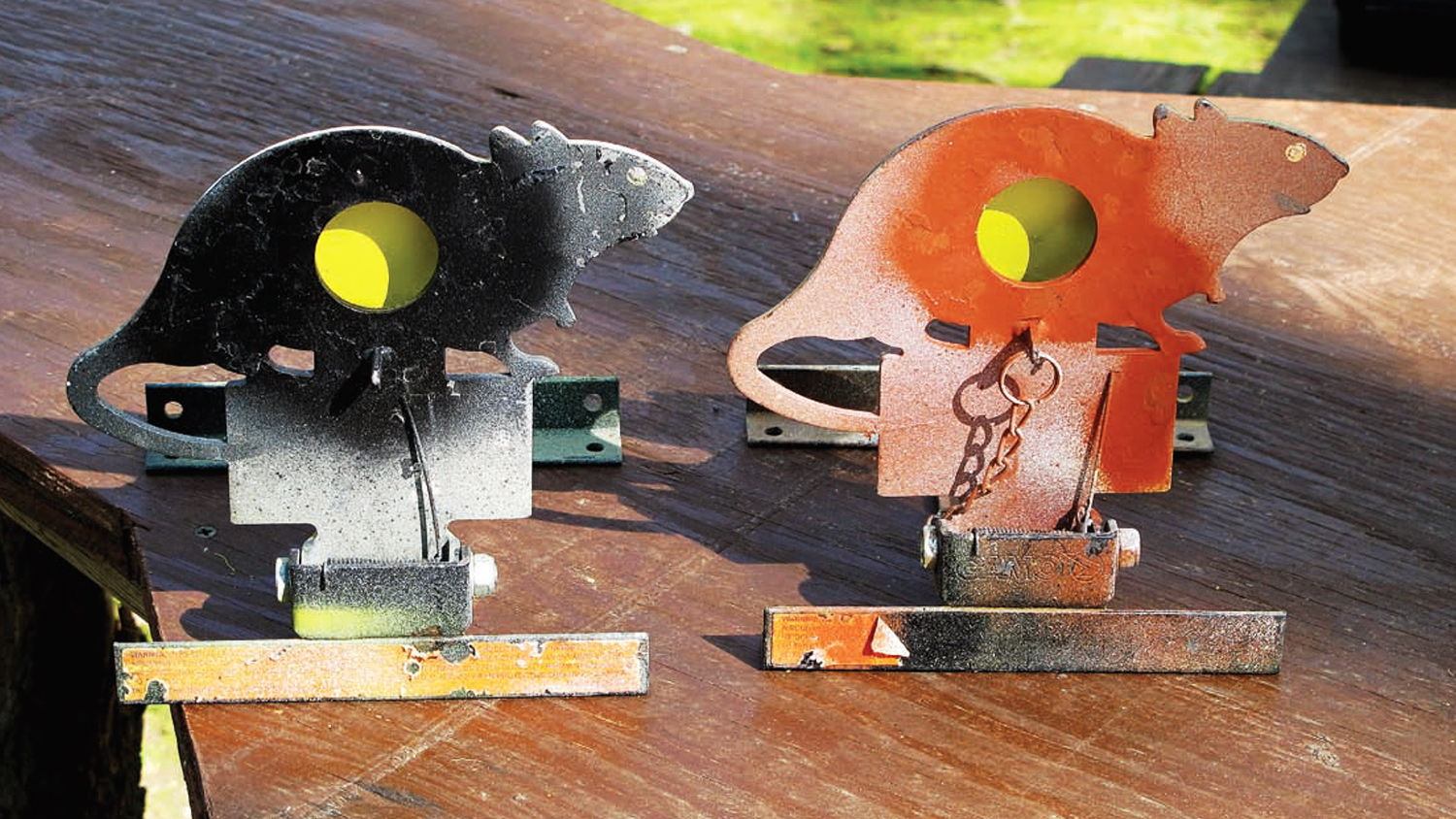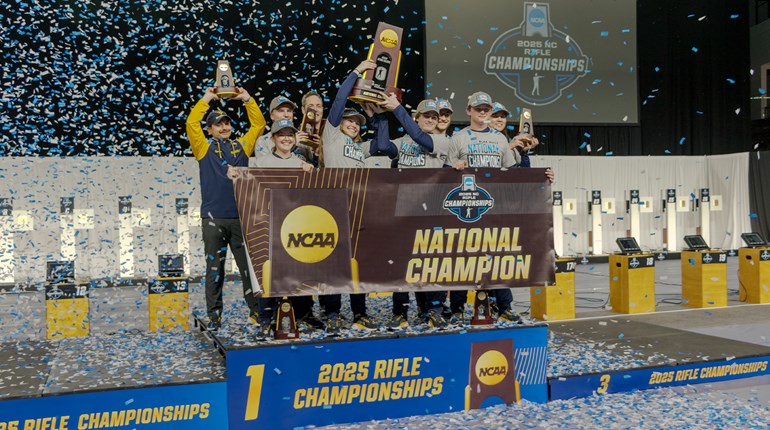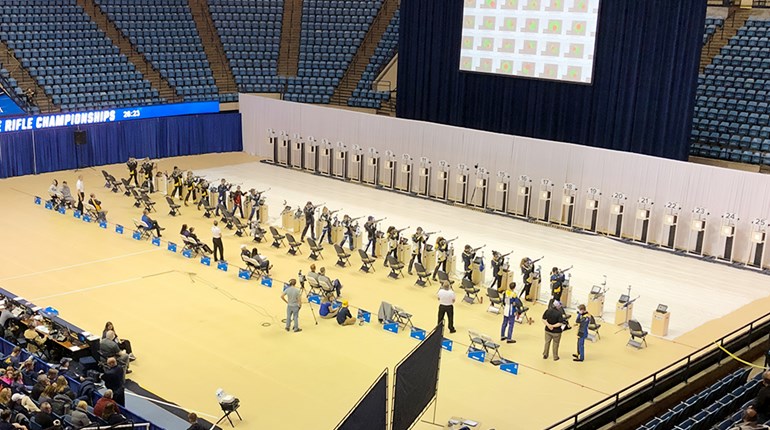
Want to have more fun than you ever thought possible with an air rifle? Then consider Air Rifle Field Target competition.
What is Field Target?
The sport of field target involves shooting at metallic animal silhouettes: crows, squirrels, rabbits, turkeys, pheasants, armadillos, snakes and the like. Each target has a hole in it—a kill zone, behind which is a paddle. Put your pellet cleanly through the hole, hit the paddle, and the target falls down. If your pellet grazes the edge of the kill zone on its way through or simply hits the face plate, the target locks in the upright position.

Sounds easy, right? But wait; it gets better. The size of the kill zone varies from target to target. One target may have a kill zone as small as a quarter inch, while another may have a kill zone nearly two inches wide. Furthermore, the targets are placed at non-standard distances ranging anywhere from 10 to 55 yards. That one-inch kill zone that looked easy at 10 yards appears downright minuscule when it’s placed way out at 55 yards. And there is no correlation between the size of the kill zone and the distance to the target. The decision to put what size kill zone at what distance is entirely up to the match director. A good match director will usually come up with a course of fire that involves a mix of outright “gimmies” (big kill zones at close range), challenging shots and bona fide “groaners” that have the competitors muttering, “You’re kidding me, right?”
Finally, in most cases, the shooter does not know the distance to the target. Air guns used in U.S. field target matches are limited to 20 foot-pounds of energy. This means that most of the air rifles are shooting fairly loopy trajectories compared to rimfire or centerfire rifles.
The Match

Matches typically consist of two or three targets per lane, two shots per target, and 10 shooting lanes, resulting in a 40- to 60-shot match. Most shots are taken from a sitting position, although many match directors will mix in some standing and kneeling shots as well. You get one point for each target that you drop and nothing if the target doesn’t go down. Most field target competitions take place outdoors, although some clubs host offhand-only matches in the winter in which shooters stand in a heated building and shoot at outside targets. (I’ve shot previous matches based on a risk/reward scoring system. You got one point for knockdowns from prone, sitting, or kneeling positions and two points for the more difficult offhand knockdowns. The shooter got to choose.)
When you mix all of these factors together, you get a sport that requires (a) figuring out the distance to the target, (b) compensating for your gun’s trajectory at that distance, (c) doping the wind and (d) executing the shot with enough precision to put the pellet cleanly through the hole. What makes it fun, in fact darn near addictive, is the immediate feedback from the targets and the fact that each match is unique.
Across the Pond
Although there is some debate about it, field target appears to have originated in the early 1980s in England. Americans adopted the idea soon thereafter and, as a result, two different strains of the sport have evolved over time. The English field target rifles and those shot in the World Field Target Federation (WFTF) are limited to 12 foot-pounds of energy. In general, WFTF field target courses are set up with larger kill zones and longer distances than their American counterparts. An American shooter who went to the World Championships marveled at the International shooters’ ability to read the wind and compensate for it with their low-power (12 foot-pounds) guns.
At present, there are more than three dozen field target clubs spread across the United States, and there are dozens more around the world. At most U.S. matches you’ll find two competitive classes: Pre-charged Pneumatic (PCP) and Piston Air Guns. Some clubs also have classes for junior shooters, offhand shooters, WFTF shooters and hunter class (limits scopes to 12X and allows the use of shooting sticks and seats). A typical entry fee for a match is $10 or less.
What’s in your Gear Bag?
So what do you need to compete in field target? First, an air rifle. You can enter with almost any .177, .20 or .22 cal. air rifle that generates less than 20 foot-pounds at the muzzle. To be competitive, you’ll want a rifle capable of shooting one-hole groups at 10 yards and holding a half-inch group at 30-35 yards.

PCP class guns are powered by compressed air stored in a cylinder usually located below the barrel of the gun. PCP guns are typically charged using a SCUBA tank or a high-pressure hand pump. Purpose-built PCP-class field target air rifles often have adjustable stocks, including butt plate and cheek piece, match triggers, and free floating barrels. In short, they have all the sophistication of an Olympic 10-meter match air rifle, but with more power. There are many PCP Class pre-charged field target rifles that will shoot sub-minute of angle groups at 50 yards. A full-out Open Class air rifle can run $1,000-$3,000 without optics.
Piston Class rifles rely on a spring or a gas ram that is cocked, usually by a lever under the barrel, to supply the energy to drive the pellet. When the trigger is pulled, the spring or ram is released, driving the piston forward and the pellet down the barrel. Because a lot of machinery is moving inside the gun before the pellet leaves the muzzle, piston air rifles are more difficult to shoot accurately. As a result, it is unusual to see Piston Class shooters equaling the score of top PCP Class shooters at a field target match. Highly accurate piston air rifles suitable for field target can be purchased for $500-600. In the right hands, a piston rifle can produce dime-sized groups at 50 yards.
Second, you’ll need high quality optics. Many field target shooters favor very high power scopes—a minimum of 24X. Shooters use them to range the targets by adjusting the objective lens until the target is clearly in focus, and then reading the distance off the front bell or side wheel of the scope.
Having determined the distance to the target, the shooter then needs to make adjustments for the loopy trajectory of the air rifle. Some shooters figure out their trajectory either by shooting at various distances at a sight-in range or by chronographing their guns and then plotting the trajectory with ballistics software.
When you know the trajectory of your gun, you can: (a) hold-off to compensate for the rise or drop of the pellet relative to your sight-in-distance or (b) click the scope’s elevation knob until the crosshairs are dead-on at the yardage to the target. A number of sources sell custom oversize elevation knobs that can be calibrated with trajectory and yardage of your gun so that you simply spin the elevation knob to the correct yardage, hold dead-on, and pull the trigger. It’s a slick system that works well when used correctly.
Having said that, note this: It’s easy to make a hash of compensating for trajectory (whether you are counting clicks or using a custom elevation knob) by simply returning the knob to zero in the wrong direction. It’s an all-too-easy mistake to make and messes up every following shot until you figure out what’s gone wrong.
As a result, many field target shooters, particularly those in Hunter Class where optics are limited to 12X, are using mil-dot scopes to provide additional “hold-off” aiming points for different distances. Using mil-dots, there is no elevation knob twisting, and you can’t return to zero in the wrong direction.

It’s simple to adapt a mil-dot reticle for use with an air gun. You don’t need to know the velocity of your gun, the height of your scope, what style of mil dot you have, or even how many clicks there are in a given range of elevation. All that is required is to zero your gun at, say, 10 yards. Then back up to 15 yards and trigger another shot, using the same point of aim. When you look through the scope again, carefully center the crosshairs on your original point of aim and take note of where the pellets landed—for example, halfway between the crosshairs and the first dot up. Now mark the 15-yard point of impact on a printout of your mil-dot reticle. This becomes your new aim point for 15 yards. Repeat the process at five-yard intervals and soon you’ll have mapped out a chart of all the points of aim for distances out to 55 yards.
To put the mil-dot to use in a practical situation, all you need to know is the range to the target (which you obtain by eyeball estimation or using the focusing ring on the scope). Then glance at your mil-dot chart to see which aiming point you use for that range, and you’re ready to shoot.
This system, however, is not foolproof. If you have a variable-power scope, you must use the scope at the same power at which you mapped your aiming points. Otherwise, you’ll shoot too high or too low at your intended distance because the relative distance between dots changes with the magnification. A few scopes compensate for this as you zoom the scope, but that is not usually the case.
The final thing you will need is something to sit on, since the majority of field target shooting lanes are designed for the sitting position. I use an old boat cushion, but whatever gets your rump off the dirt and is comfortable ought to work just fine.

But you don’t need the best of the best to go out and have some fun with field target. Recently, I saw an online retailer offering a .177 caliber German break barrel air rifle with scope, suitable for shooting in Hunter Class, for just under $200. It also appeals to my Scottish “thrift” genes that, once you pay for the air rifle and scope, field target competition costs just pennies per round.
Ammunition
Once you have an accurate air rifle, some good optics, and a means of dealing with the trajectory of your air rifle, you’ll need some good ammunition. Air rifles are notorious for “liking” one pellet over another. You have to test to see which one your gun likes, and then stick with it. Group size can shrink dramatically simply by choosing the right pellet. It doesn’t matter what everyone else is shooting in their guns, it only matters what works in your gun.
Even when you don’t do well at field target, it can still be a lot of fun. Field targets shooters are, by and large, friendly and generous with their time and expertise. Match directors usually divide the competitors into squads that will stay together as they shoot each lane. At every match that I’ve shot, somehow I’ve managed to be on a squad with other shooters who added to the enjoyment of the match with encouragement, a helpful word or two and, of course, a little good natured kidding. Looking back, I’ve never come home from a match wishing I hadn’t gone.
The bottom line: Field target delivers a lot of fun, great camaraderie, and the challenge of a high-accuracy sport at a reasonable price. Even better, for most shooters, you can practice in your backyard. If you already have an air rifle stuck in the closet, drag it out, pop a scope on it, and get ready to have some fun.
Resources
To find out more about field target, visit the American Air Gun Field Target Association website: www.aafta.org. AAFTA has a list of field target clubs in the United States as well as a resource page of suppliers of field target air rifles, scopes, ammunition, etc.


































